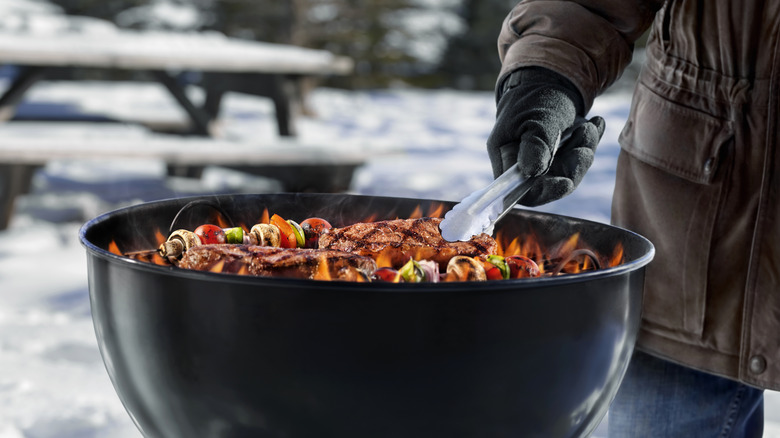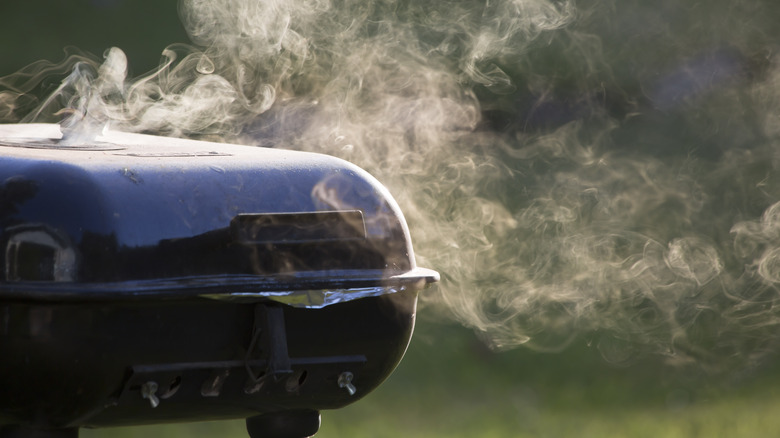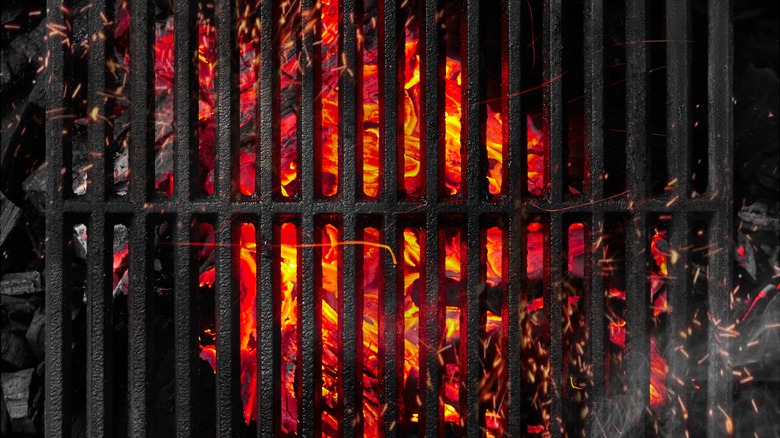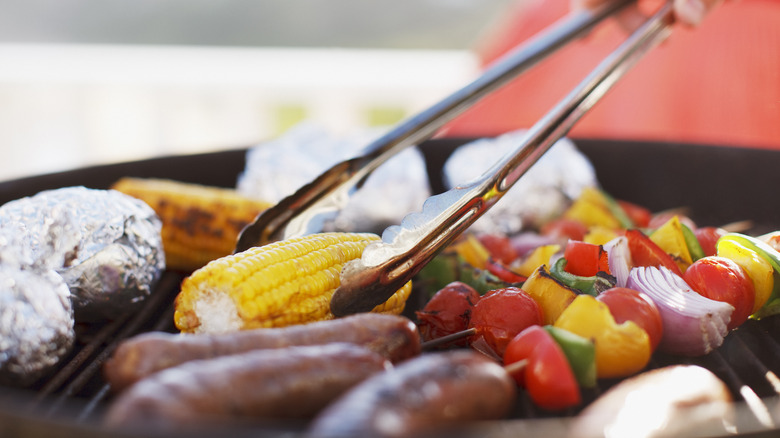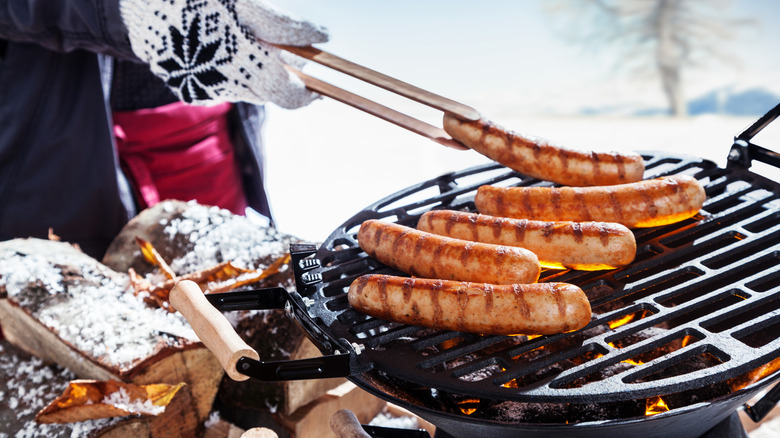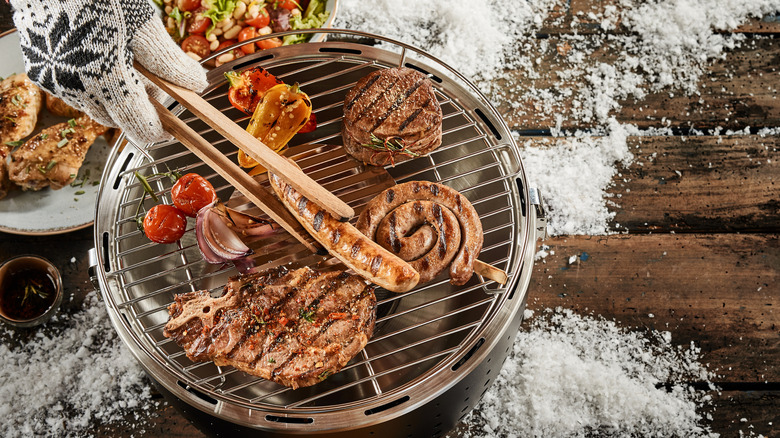5 Things You Need To Know Before Grilling In Cold Weather
Winter shouldn't signal the end of grilling season. While many home cooks believe a drop in temperature means they should opt to cook steaks and chops indoors, your grill can continue to dazzle with sizzling heat, perfect chars, and smoky flavors with the right preparation and a few simple hacks. Besides, there are few things better than a hearty cookout during the holiday season. Friends, family, and fun all gathered together to eat good food — what could get us more in the holiday spirit?
Whether you're using a charcoal or a gas grill, the following five grilling tips will tackle the best ways to keep the heat of your grill up, which food items are best for wintertime grilling, what weather or outdoor conditions you should watch out for during cooking, what to bundle up with, and how to avoid any potential fire or health hazards as you sear your favorite recipes. In the end, you may be shocked at just how easy grilling in the cold can be.
Keep the lid of your grill closed as much as possible
Thermodynamics, or the study of heat and energy in physics, explains that as air molecules heat up, they begin to lose density and rise over heavier, colder air. This physics principle becomes crucial for grilling in the wintertime where temperatures between your grill and the environment will vary vastly. To keep it simple, opening your grill lid allows all the hot air you worked so hard for to escape. The longer it remains unclosed, the more heat escapes, and the more likely your cooking will take longer and your meat and veggies turn out uneven.
Still, one of the appeals of open-grill cooking lies in the fact that the food remains visible. A closed lid means grill food can no longer be eyeballed for readiness, which may be challenging for outdoor cooks used to visual cues for doneness. To ensure meat has reached a safe temperature, a grill or meat thermometer can be used to check for heat and doneness more accurately — and, vitally, more quickly.
A cast iron grill gate will maximize heat retention
Cast iron has remained a longtime favorite for cooks and pitmasters for its ability to retain heat over long periods of time, as well as its overall durability when compared to aluminum or stainless steel. The same rules apply to grills, and when it comes to maintaining the fluctuating temperatures of charcoal in particular, cast iron grill gates are able to hold in heat much better than their flashier counterparts. Plus, if taken care of properly, they offer a sturdier surface area that will not only sear better but stick to your food less.
The downside of these grill gates? They tend to take a little longer to heat up. However, winter grilling takes more time in general, as those chilly temperatures will constantly work against your burning charcoal or gas. If you aren't grilling in a rush, the benefits of letting your cast iron grill warm up will show in those beautifully seared steaks and vegetables. Just don't forget how long your meat needs to rest after grilling in order to maximize juiciness.
Choose quick-cook foods and stock up on fuel
Fuel costs also add up during winter grilling. You'll need more gas or charcoal to compensate for icy temperatures, so you can reach those desired temperatures for safe cooking. Once you're out of the pre-heating phase of grilling, keeping that fuel going becomes even more important. Whether you swear by charcoal or gas, you're going to need extra in the long run, so you'll want to ensure you can cook food in a flash.
For starters, slab bacon, scallops, and bok choy can be on and off the grill in 15 minutes, as their small size will cook under those flames considerably faster than a large rack of ribs or beef roast. Regardless, don't feel pressured to abandon those outdoor steaks just yet — especially if you're using cast iron grill gates and keeping the lid closed — but be aware that you'll need much more fuel than you probably used in the summertime.
Wear heat-resistant gloves to keep your hands warm and cozy
Your grill should not be the only thing that should be warm whenever you're cooking outdoors in the wintertime. Hypothermia can commonly occur in degrees as high as 50 Fahrenheit, and while some warmth may radiate during the cooking process, it should not be the only thing protecting you from frostbite and other weather-related injuries.
Bundle up with extra winterwear — ideally, pieces you're not afraid to get a little dirty. For your hands, which are likely to get much closer to the hot grill than the rest of your body, pick gloves that are not flammable and allow for flexibility. Just keep in mind that open-fingered gloves are not your friend in frigid temperatures, as the body's extremities are the most vulnerable to frostbite. Also, be sure to tuck in any scarves or loose articles of clothing that could run the risk of touching an open flame.
Keep your grill at a safe distance to avoid fire hazards
A house or forest fire is probably the last thing anybody wants while grilling, but, unfortunately, cooler weather does not mitigate that risk. While you might be tempted to bring your cooking closer to home, remember to keep your grill at least 10 feet away from buildings to avoid any accidents from getting out of hand. Also, never use an outdoor grill in an enclosed space such as a garage or tent, as you run the risk of breathing in unwanted carbon monoxide.
Your home can still work to your advantage, however. When pesky winter winds make heat retention a nightmare, strategically place your grill in a spot where a building can act as a barrier between you and the weather. Once you find the best, least windy place to cook, make sure to clear any potential ice or snow that may hinder your movement — or worse yet, cause you to trip and knock over hot charcoal or gas.

